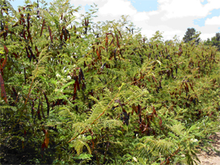- Acacia angustissima
-
Acacia angustissima 
Conservation status Scientific classification Kingdom: Plantae (unranked): Angiosperms (unranked): Eudicots (unranked): Rosids Order: Fabales Family: Fabaceae Genus: Acacia Species: A. angustissima Binomial name Acacia angustissima
(Mill.) Kuntze
Range of Acacia angustissima Synonyms - Acacia angulosa Bertol.
- Acacia elegans M.Martens & Galeotti
- Acacia filicina Willd.
- Acacia filicioides (Cav.)
- Acacia glabrata Schltdl.
- Acacia hirsuta Schltdl.
- Acacia insignis M. Martens & Galeotti
- Acacia pittieriana Standl.
- Acaciella angulosa (Bertol.) Britton & Rose
- Acaciella angustissima (Mill.) Britton & Rose,
- Acaciella costaricensis Britton & Rose
- Acaciella holtonii Britton & Killip
- Acaciella martensis Britton & Killip
- Acaciella rensonii Britton & Rose
- Acaciella santanderensis Britton & Killip
- Mimosa angustissima Mill.
- Mimosa filicioides Cav.
- Mimosa ptericina Poir.[1]
Acacia angustissima (Prairie acacia, White ball acacia) is a perennial, deciduous, shrub or tree in the Fabaceae family native to Central America and the United States. It is also found in South America, India and Pakistan. Other common names for it include Carboncillo, Timbe, Timbre,[2] Fern Acacia and Prairie wattle.[3] It grows 1m to 4m in height having whitish, 1.3 cm diameter spherical flowers from June through September. "Angustissima" in Latin means "narrowest," describing the look of the shrub's leaves.[3] It is not listed as being a threatened species.[2]
Contents
Natural habitat
Altitude: 0-2600m
Annual Temperature Mean: 5-30 deg. C.
Annual Rainfall Mean: 895-2870mm
Soil: A. angustissima is well-suited for acidic, low-nutrient soils and it has very good resistance to drought.[4]Uses
Alcoholic beverages
The bark is used in the production of alcoholic beverages.[4] The root is used in the drink pulque in Mexico.[5]
Forage
Acacia angustissima's seeds are high in protein and are somewhat useful as forage for livestock.[2] The tree has a tannin content of 6%, which inhibits the ability of livestock to make use of the tree's protein.[4]
Medicine
The indigenous Tzotzil and Tzeltal Maya people of Mexico use A. angustissima to treat digestive tract problems. They also use it to treat toothache, rheumatoid arthritis and cuts of the skin. Experiments have shown that A. angustissima mildly inhibits the growth of Escherichia coli and Staphylococcus aureus.[4]
Propagation
There are 90,000–100,000 seeds/kg.[6]
Botanical varieties
- Isely
- edit] See also
References
Notes
- ^ "- ILDIS LegumeWeb". www.ildis.org. http://www.ildis.org/LegumeWeb?version~10.01&LegumeWeb&tno~15362. Retrieved 2008-05-02.
- ^ a b c Acacia angustissima
- ^ a b Native Plant Information Network
- ^ a b c d World Agroforestry Centre
- ^ Rätsch, Christian. Enzyklopädie der psychoaktiven Pflanzen. Botanik, Ethnopharmakologie und Anwendungen.. p. 15. ISBN 978-3855025701.
- ^ Tropical Forages
- ^ ILDIS Legumes of the World
General references
External links
Categories:- NatureServe Secure species
- Acacia
- Shrubs
- Forages
- Flora of India
- Flora of South America
- Entheogens
Wikimedia Foundation. 2010.



